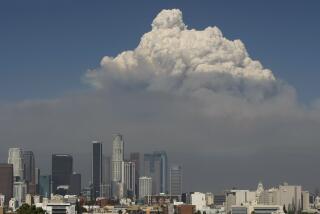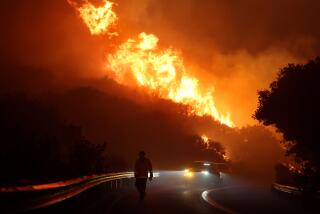Expertâs Advice Helps Crews Anticipate Erratic Behavior of Raging Fires : Rescues: Called part scientist, part gambler, Doug Campbell came out of retirement to help save property--and lives.
At the height of the Green Meadow fire, as flames swept southwest toward Point Mugu, a handful of firefighting crews began setting up equipment several miles away, to the east.
As they cleared brush in front of the expensive homes next to Lake Sherwood, the fire was barely visible, nothing more than a haze of smoke in the distance.
But when the fire turned east and sprinted toward the Lake Sherwood neighborhood and its 160 homes, the firefighters were ready for it.
The night before, they had received a confidential memo from fire behavior expert Doug Campbell. In it, he outlined predictions for the fireâs movement.
âI told them to expect a threat to the Lake Sherwood homes, and to have crews there in sufficient number to fight it off,â Campbell said Thursday night. âThe fire did just what I thought it would do.â
Campbell, a 59-year-old Ojai native who recently came out of retirement to help the Ventura County Fire Department predict the movements of large fires, is considered a guru in the field of fire behavior.
He is part scientist, part gambler, and those who rely on him say that, when it comes to predicting a fire, he is never wrong.
âHe just has this way of reading the fire,â said Terry Raley, the planning section chief for the Green Meadow fire. âThereâs nobody else like him. He pins it down to a gnatâs ass every time.â
Campbell said he began studying the science of fire behavior in the mid-1960s, after one of his close friends in the U.S. Forest Service led a crew of 13 men into the mouth of a forest fire.
âThey got to a place where they couldnât move, and the fire moved,â Campbell recalled. The entire crew was killed.
âThat really shook me. I mean, I knew all of those guys and they were good firefighters. I realized if it could happen to them, it could happen to anybody.â
The son of a firefighter, Campbell began work with the forest service when he was only 16. Death was something he had rarely thought about.
âI took the job because it had everything I was looking for: danger, excitement, places you could use your brain, and places where you could use your muscles. I liked the danger.â
But that outlook changed over a 35-year career, which included a 14-year stint as fire chief for the U.S. Forest Service in Ojai. Campbell said 28 of his friends have been killed by fires that overtook them.
âI now feel that all of those situations were predictable,â he said. âThatâs what pushed me to do this. It pushed me to come out of retirement until I felt I could pass this knowledge along to other firemen.â
Campbell said the purpose of fire prediction is to help prevent a situation in which a fire crew finds itself overrun by a sprinting blaze.
In a two-hour stretch on Thursday afternoon, the Green Meadow fire switched directions as the wind shifted and consumed 2,500 acres. Campbell had tipped crews off to the sudden wind change the night before, telling them when and where it would go.
âThe advantage in that instance was that they were ready for the fire tactically. They werenât surprised by what it did.â
To make that prediction, Campbell weighed several factors. He calls it âlistening to what the fire is telling you.â
The most important element to consider when predicting a fire, Campbell said, is the weather.
Campbell pours over forecasts throughout the day, constantly waiting for updates on the types of winds to expect and the direction and speed they will move.
He examines the terrain and plant life around the fire. He looks at the location of the plants that the fire would most like to consume.
He requests relief maps so he can study the topography of the land around the fire. Which slopes will be lit by the sun and which will be in the shade? Is the fire at the bottom of a hill or the top?
âEssentially,â he said, âthe forces are aligned to push the fire in a certain direction. If itâs at the bottom of a hill, it wants the hill. If you throw wind behind it, it wants the hill worse. And if the sun is heating it up, it wants the hill even worse.â
Although Campbell talks about the fire in human terms, he does not believe fires have personalities.
âItâs not like you see in the movies,â he said. âThis is a very technical job. Iâm taking real factors and using them to reach conclusions. Of course, this is not an exact science. My job is to reduce the chance of error.â
Campbell, who recently completed a book on the subject of fire behavior, said his goal is to look out for the firefighters.
âI want to be the guy who whispers in their ear and says, âLook out over there, itâs coming over that ridge in a few minutes. Be ready for it.â â
Over the course of the past week, Raley said, that voice has saved lives.
âWith the predictions heâs given us,â Raley said, âhe has lessened our injuries to very, very little. You canât put a measure on what he does.â
More to Read
Sign up for Essential California
The most important California stories and recommendations in your inbox every morning.
You may occasionally receive promotional content from the Los Angeles Times.










